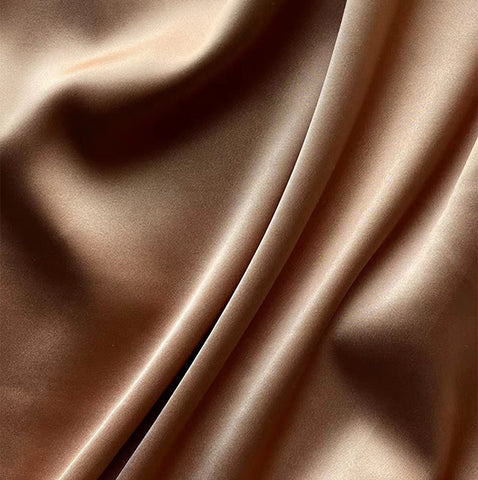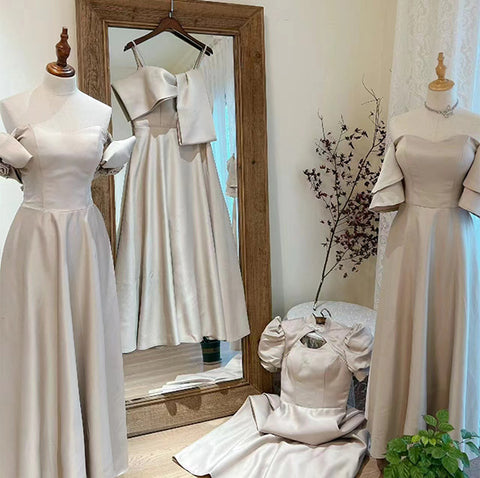

Satin is a weave with a smooth, glossy front side. Satin fabric, which is often woven with silk and synthetic fibers, is a great choice for bridesmaid dresses.

“Satin is a woven fabric with a high silk content, known for its luxurious sheen and smooth drape”, according to Leslie Ceci, the fashion historian. Satin is woven by floating warp yarns across the weft before going beneath one weft thread and starting the cycle again. Satin weaves consist of at least four weft threads overlapping a warp thread. This gives satin its lustrous and shiny appearance.

Image Source: Wikipedia
History has it that satin, which was initially made only of silk originated from China. At the time, silk was found and produced majorly in China. The word “satin” was coined in China from Quanzhou, a Chinese port city. However, in medieval Arabic, the city was referred to Zaitun due to pronunciation differences. Zaitun became prominent hence the name satin.

Image Source: Wikipedia
“Satin's popularity as a bridesmaid dress fabric can be traced back to the Victorian era, where it symbolized elegance and wealth”, says Mary Mitchell, curator at the Museum at FIT. During the 12th century, silk satin was introduced into the European market. The fabric was also very expensive because it was imported and only the elite and upper-class citizens wore satin fabrics. Satin was the wedding gown of choice for the daughters of the wealthy back then. This was because it is symbolic of class and luxury, making it an excellent choice.

Satin is a soft, breathable and durable fabric. It is smooth to the touch but can feel slightly coarse due to the matte finishing on the opposite side of the fabric. However, silk satin is more soft and breathable than synthetic satin. In addition, satin is a draped fabric.

Satin shares similarities with some other fabrics. Here are a few examples:

“Traditionally, satin was made from pure silk, but today, it's also commonly woven from synthetic fibers like polyester, offering a more affordable option", says Sarah Mills, textile expert at TEXINTEL. Satin is a soft shiny fabric made of filament fibers such as silk, polyester, cotton, rayon, or nylon. However, some definitions insist that satin is made from only silk.
There are various types of satin and this is based on the type of fibers used in the weave. As well as the category of satin weave used. Below are a few types of satin and their characteristics:

This satin type is woven with slubbed spun yarns as the weft threads. Antique satin is a heavy and dull fabric which makes it useful for making bedding, curtains and upholstery.

Baronet satin uses cotton weft threads and rayon warp threads. This gives the satin an extremely lustrous nature.

From the French word “charmer” which means lightweight. Charmeuse satin is a lightweight fabric with an easy drape. Its characteristic features are its shiny front and dull back. According to Christian Siriano, a fashion designer; “For a more fluid and romantic look, charmeuse satin is a great choice. Its lighter weight allows for beautiful movement and cascading effects.” This type of satin is often used for making wedding and bridesmaid dresses.

This type of fabric is usually woven from either silk or rayon. Its characteristic feature is its lightweight and high shine.

According to Vera Wang, a fashion designer, "Duchess satin is a personal favorite for bridesmaid dresses. It has a heavier weight and a more structured drape, creating a sophisticated silhouette.” Unlike other types of satin, duchess satin is stiffer and has less lustre.
Some people think satin is mainly useful for making bridal dresses and evening gowns. That is true, but satin can be used for more than just dresses. Satin is used in a variety of applications, including interior decoration and accessories. To mention a few uses:

Satin is a staple fabric for all types of wedding dresses; bridal gowns, bridesmaids dresses, and wedding guests' dresses. It is also used to make evening gowns and dress accessories such as neckties and scarves. Satin is also used in casual wear, such as lingerie, nightgowns, loungewear, and underwear. Satin's lustrous nature and beautiful drape make it ideal for making these dresses.

Satin is used to make fashion accessories such as brooches, purses, clutches, neckbands, evening bags, and so on. It is used to design the exterior of these items, giving them a shiny finish and a soft touch.

Satin is prominent for adding luxury to any design which makes it useful for making bedding materials. Bed sheets, linens, and pillow covers are all examples of bedding. Satin's soft and flexible weave makes it an ideal fabric for bedding.

This is one of the earliest uses of satin in Europe, specifically. Satin is used to decorate furniture, such as chairs and cushioned furniture. Aside from furniture, satin is used to make interior finishes such as curtains.
Satin has several characteristics that make it ideal for bridesmaid's dresses. Aside from the fact that it looks stunning in any color palette.

The brilliant shining feature of satin bridesmaid dresses is amazing. Whenever you see a satin bridesmaid dress, there is this characteristic shine it gives. Such that it perfectly complements the skin tone of the bridesmaids. Satin works perfectly with diverse colors, from subtle hues to vibrant tones.

How does it feel to wear a dress that hangs effortlessly on the body? Awesome, if you would agree with me. Satin fabric is rich in high-quality fibre making it very pliable. According to Lisa Ferla, bridal boutique owner; “Satin offers a luxurious look at various price points. Whether it's pure silk or a high-quality synthetic blend, satin bridesmaid dresses always exude a touch of elegance”.
Satin bridesmaid dress also has a way of enhancing the silhouette and dress variations. And effortlessly revealing the body figure of the bridesmaid. As a result, it is an ideal bridesmaid dress fabric.

Bridesmaid dresses produced from satin fabric are long-lasting and durable. Such that the dress can be reused subsequently for other events. Without showing any signs of wear and tear. This feature is characteristic of satin fabrics, most especially, polyester satin. The tautness of satin weaves is responsible for its durability. Making it a good fabric option for bridesmaids' dresses.

Satin is versatile and impartial, whether you want an extravagant or minimalist look for bridesmaid dresses. "Satin is a timeless fabric that photographs beautifully. It reflects light in a way that flatters all body types, making it a versatile choice for bridesmaid dresses”, says celebrity stylist, Mark Ingram.
You can improvise on satin to execute whatever looks you want to create. This further implies that your bridesmaids can appear elegant in any dress style they choose. Also, the varying sides of the satin fabric, gloss and matte give room for even more versatility. Both sides of satin can be used to sew the bridesmaid dress. This enables the bridesmaid to be flexible in their appearance.

Another reason designers prefer satin is that it does not wrinkle easily. However, this is determined by the thickness of the satin. The thicker the satin fabric, the less wrinkle-prone it is. Unlike other fabrics, which wrinkle after sitting for a few minutes. Bridesmaid dresses made of satin do not wrinkle easily, even after sitting during bridal events. These are some of the creases that wedding designers avoid. This is why satin, duchess satin especially, is a better fabric for bridesmaid dresses.
Satin bridesmaid dresses! Whether you are looking for a simple style or an extravagant style. These satin bridesmaid dress trends are your go-to choice. These designs are not only classy and sophisticated but also contemporary. To mention a few of the high-end satin bridesmaid dress trends:

The one-shoulder satin dress is a fantastic trendy bridesmaid style. This style is an ideal choice for a less extravagant bridesmaid appearance.

Off-shoulder dress is the latest trend revolving in the fashion industry. Off-shoulder satin bridesmaid dress is suitable for a vintage-themed wedding.

The strapless satin bridesmaid dress is an ideal bridesmaid design for a classy look. This trending style gives a sophisticated and perfect look for an indoor wedding theme.

Satin bridesmaid dress dresses and asymmetric hemlines are a part of the trendy style. The asymmetric hemline adds beauty and glamour to the bridesmaid dress.

The slit satin dress is one of the top bridesmaid dress trends. Whether it is a thigh-high or side slit, it gives the bridesmaid dress an extra touch of romance. This dress trend also creates a fascinating and elegant look.

The cowl neck bridesmaid dress is a trendy neckline variation style. This neckline brings out the beauty in the bridesmaid dress by making it even more unique. It can be incorporated into any wedding theme.
Satin is a shiny and durable fabric often used for special events such as weddings and dinner parties. The shiny and slippery nature of satin makes it stressful to work with. But, we will walk you through the process of sewing a satin bridesmaid dress:

The first step when using satin for sewing a bridesmaid dress is to cut your dress pattern. Use a rotary cutter or fine sharp scissors to cut the fabric to do it accurately. This is due to the slippery and shiny nature of satin.

Press your satin fabric on medium heat to prevent burns. Lift and drop the iron as you carefully work it through the satin. Do not drag the iron across the fabric.

Cut your fabric according to the pattern and press it properly. The next step is sewing the pieces together. Ensure that you have silk pins and needles in place to keep your satin snag-free.

Fold and press the hem of the fabric using a pressing cloth to void a visible line on the bridesmaid dress. For a seamless hemming process, stitch the hem using a blind hem stitch or invisible hem stitch.

The next step is to perform fittings with your bridesmaid dress inside out. To make adjustments where necessary before adding finishing touches. All these must be done without damaging the fabric and altering the style.

The final step in making your bridesmaid dress is to add the finishing touches. Add closures like zippers, embellishments, and embroideries carefully to the fabric. While attaching the finishing touches, avoid pulling the fabric. Give your bridesmaid dress a final press after crossing all your t's on the dress.

Sewing with satin can be difficult because it's slippery. However, with these tips, you can run satin through your machine with more ease.
Check out some tips below:

After the production of synthetic satins, the fabric has become widespread. You can get your satin fabric from any fabric store. However, you might see different qualities of satin there. Silk satin is more expensive which can be hard to come by in a random fabric store.

Due to the fragility of satin, if you wash it incorrectly, it can easily cause permanent damage to the satin surface. We generally recommend that you choose hand washing and professional care. And for those who like to clean bridesmaid dresses by themselves, we recommend you read this professional article: How to Wash Satin Bridesmaid Dresses, which can make your dress as clean and tidy as the day you bought it.
Satin can be sustainable if it is ethically produced from organic or recyclable materials and fibers. An example is synthetic satin which is made from recyclable fibers like cotton, rayon, and polyester. Satin may not be entirely sustainable, posing a threat to certain wildlife and the environment. Overall, the production process and materials used to make satin determine its sustainability.
Satin is one of the most popular fabrics for bridal fashion, including wedding dresses, capes, and wedding jackets. The shiny, lustrous, and lovely drape of white, pink, nude, or ivory satin fabrics. Is known for making bridesmaids look stunning and radiant. Whether you choose a simple or elaborate bridesmaid dress. Consider using satin for these!